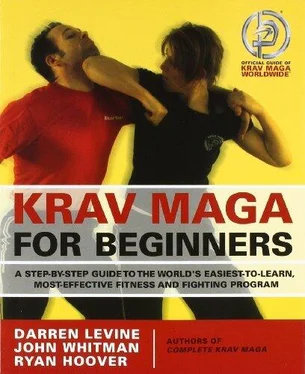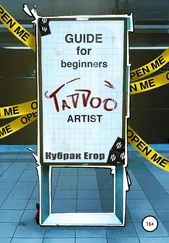In 1983, at Imi’s urging, Darren, with the help of prominent members of the Jewish community, including Joel Bernstein and Mark Lainer, formed the Krav Maga Association of America, Inc. The goals of this organization were to regulate and promote Krav Maga in the United States, as well as to help promote good relations between the United States and Israel.
Every summer after Imi’s visit, Darren would either go to Israel to train in Krav Maga, or Imi himself would return or send a top military or civilian instructor to the United States to train Darren. At the end of I984, Darren received his first-degree black belt in Krav Maga. At Darren’s belt award ceremony, Imi’s black belt was passed on to him. Darren also received his full instructor teaching certification from the Wingate Institute for Physical Education and Sport and the Krav Maga Association of Israel that same year. In 1985, Imi penned a letter recognizing Darren as an expert in Krav Maga.
Through the Krav Maga Association of America, Darren and his top students began teaching Krav Maga to law enforcement in the United States. Darren also worked to adapt Krav Maga to suit the needs of U.S. peace and military officers. Imi came back to the United States in 1987 to help Darren teach Krav Maga to the Illinois State Police, and in 1988, Imi and Colonel David Ben-Asher co-wrote yet another letter identifying Darren as an expert in Krav Maga for law enforcement.
Darren continued to teach Krav Maga at Heschel until 1987, when he moved the classes to the University of Judaism. Classes at the University of Judaism continued until 1996, when demand for Krav Maga was so great that the Krav Maga National Training Center was opened in West Los Angeles. It was the first center of its kind, blending Krav Maga with a fitness program and establishing a training ground for civilians and law enforcement personnel that previously had never existed anywhere in the world.
Imi was quite proud of the growth and success of Krav Maga in the U.S. In 1997, shortly after Darren received his sixth-degree black belt in Krav Maga, Imi awarded Darren a Founder’s Diploma for Special Excellence in Krav Maga. Imi gave this diploma to only two individuals, Darren and Eyal Yanilov, the Director of the International Krav Maga Federation. These diplomas were given to the people that Imi wanted to be the leaders of Krav Maga.
In January 1999, Krav Maga Worldwide Enterprises was formed to facilitate the expansion of the Krav Maga system throughout the U.S. and around the world. Imi, through his words and actions, viewed Darren Levine as the person most capable and qualified to develop techniques, train instructors, and adapt Krav Maga based on the needs of American citizens and law enforcement agencies. As a result, Krav Maga Worldwide, under the expert direction of Mr. Levine, has successfully maintained the integrity of the Krav Maga system and principles, as intended by Imi. Krav Maga Worldwide has also been responsible for keeping Krav Maga relevant and up to date, specifically for the unique and changing needs of the citizens of the United States and other industrialized nations.
Krav Maga Worldwide has had great success in exposing Krav Maga to hundreds of thousands of people throughout the world, while also getting the system approved and recognized for use by more than 200 law enforcement agencies. Krav Maga Worldwide is also intimately involved in training some of the U.S. military’s most elite units. Krav Maga continues to thrive in the U.S. and abroad, and it is the objective of Krav Maga Worldwide to continue to present the best in self-defense training to as many people as possible.
Once you’ve made the decision to begin your Krav Maga training, there are several items to keep in mind to insure the best training experience. Hopefully, you’re able to find a certified Krav Maga Worldwide instructor (see page 11 for more information), and your instructor will be sure to speak to these considerations as well.
Preparing for a Training Session
In order to get the most out of your sessions, you should be prepared, physically and mentally, for the training. You should consult your physician to insure that this type of training is suitable for you.
As part of your physical preparations, you should consider a diet that will optimize your session. Eating a carbohydrate-rich meal three to four hours before training will serve to fuel your body. Eating an easily digestible snack an hour or so beforehand should give you the added boost to get you started. Since most Krav Maga sessions last an hour, water is ideal for your hydration. It’s important to drink water, not only during your training, but throughout the day.
A typical Krav Maga Worldwide class consists of a warm-up (see page 37 for details), combatives training, self-defense training, and drills. Warm-ups are designed to prepare the body both physically and mentally for the hard training ahead, but you know your body better than anyone. If you have problem areas that need extra attention (such as stretching), you should take the initiative to address this before your session begins. It’s also imperative that you notify your instructor of any injuries that you may have.
You should also spend some preparation time on getting ready mentally. As is done on the physical side, your certified instructor will employ techniques to do just this, but you should spend some time thinking about the training and your training goals before you begin the class. Simply showing up to train is a big step, but coming in with specific goals in mind, and the understanding that maximum effort will produce maximum results, will provide you with the best training experience.
Wrapping Hands
Handwraps are designed to provide wrist and knuckle protection during hard punching. While there are many ways to wrap the hands, here’s a very common and practical way.
1-2Relax your hand and spread your fingers. Place the thumb loop around your thumb and bring the wrap across the back of your hand. Wrap around your wrist two or three times, two to three inches up from your wrist joint, to insure proper support. The hand wrap should be snug, but be careful not to cut off your circulation. Note: The wrap should not be twisted at any point.
3From the wrist, bring the wrap across the back of your hand and around your palm.
4Continue the wrap across the top of your knuckles. Wrap the knuckles two to three times. Create an ʺXʺ pattern across the back of your hand by starting at the knuckles and going across the back of your hand toward your wrist and around. Replicate this ʺXʺ pattern two or three times.
Safety in Training
While your certified instructor and licensed training facility will go to great lengths to produce a safe training experience, the onus is often on the student to insure personal safety and the safety of training partners. Krav Maga Worldwide classes are designed to prepare students for self-defense in the real world. The recommended training attire reflects this goal, while also making considerations for optimal training. Lightweight nylon pants or knee-length shorts are preferred, along with a T-shirt and cross-training-type shoes. It’s also essential, in order to maintain a safe training environment and as a courtesy to fellow students, to keep these items clean. Bringing extra shirts, in order to change during or between classes, is a common courtesy all students should make a habit.
Читать дальше













